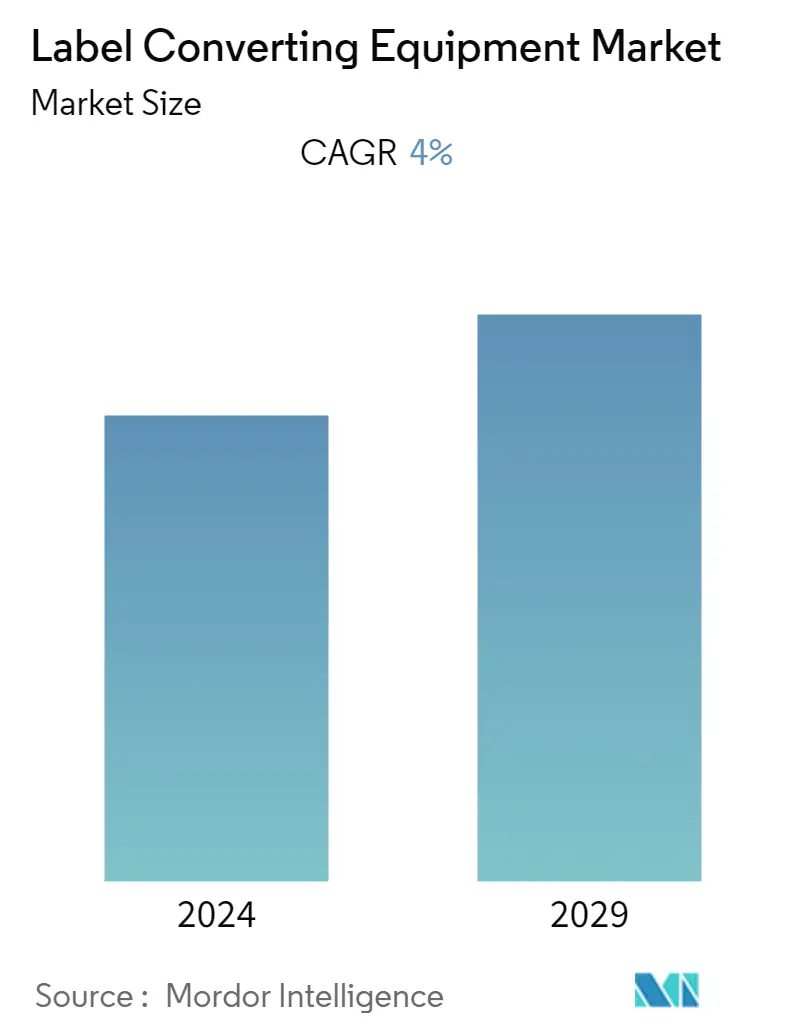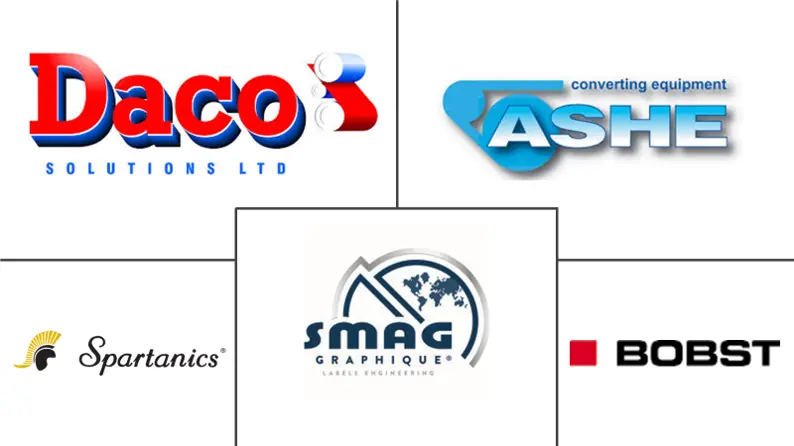Market Size of Label Converting Equipment Industry

| Study Period | 2019 - 2029 |
| Base Year For Estimation | 2023 |
| CAGR | 4.00 % |
| Fastest Growing Market | Asia Pacific |
| Largest Market | North America |
| Market Concentration | Low |
Major Players
*Disclaimer: Major Players sorted in no particular order |
Label Converting Equipment Market Analysis
The label converting equipment market is expected to register a cagr of 4% during the forecast period 2021 - 2026. Primarily a technologically-based industry is using conventional letterpress or flexographic printing for label conversion. Today the demand of brand owners for adding value in the label is becoming almost limitless with all in shorter and shorter runs with reduced lead times. While conventional servo drive flexo and offset presses will still continue to have a dominant place in the installed base of label presses for many years, it is digital, particularly inkjet, that will undoubtedly become a longer-term market leader as quality and performance continue to improve. Most certainly, hybrid conventional and inkjet presses will find a growing market alongside stand-alone digital presses in the future. Everything will continue to become more automated which reflects a future trend of the market.
- The rise of customization and premium labels drives the market. The demand is evolving rapidly towards more customization and promotion, which means smaller runs, greater cost constraints and eventually the transformation of the entire digital workflow. According to Big Presence, a digital marketing and sales solutions firm, says that 82% of investors want the companies they invest in to have a strong brand. Brands, small and large, are promoting so-called 'targeted campaigns', where the labels alone can enhance the apparent quality of a product which eventually increases the brand image. Different print effects, such as hot foil stamping, cold foil stamping, and gravure printing are used to embellish the labels to give them a more 'premium' appearance, as are tactile or haptic effects using processes like spot varnishing. Some of these enhancements can even be done digitally. This effectively drives the demand for label converting equipment.
- Increasing automation in machinery drives the market. The growing demands on label converting and greater flexibility and customization are driving the industry towards higher levels of automation across the machinery. Automation has also rapidly spread into the equipment world, reducing plate handling, plate room labor, and eliminating key areas of potential plate damage due to constant handling in label converting machinery. Moreover, the integration of newer technologies, such as UV LED technology, is also rapidly gaining adoption in the equipment world.
- The companies are adopting the solution towards automation. For instance, in 2017, Esko showcased solutions designed to improve lead time and equipment utilization, reduce errors and ensure consistent output quality regardless of the printing technology used. The company highlighted WebCenter QuickStart for Labels which is a communication bundle for label production with pre-configured process flows targeted at label converters of any size.
- The high cost of label converting equipment is restraining the growth of the market. As mostly this machinery is linked with flexographic printing for conversion, the printing plates are the most important and cost of reprographics to get to the final print stage There are also high operational costs that are linked to the use of machine. These relate to things such as costs of electricity which is used to run the machines as well as regular maintenance.
Label Converting Equipment Industry Segmentation
The label converting process is an important part of label manufacturing as it consists of a number of processes that take place after printing, all with an essential role to play in producing the final labels. The equipment mostly used are automatic and semi-automatic in various end-user segment such as food & beverage, pharmaceutical, cosmetics & household, etc.
| By Type | |
| Automatic | |
| Other Types |
| By End-User | |
| Food & Beverage | |
| Pharmaceutical | |
| Cosmetics & Household | |
| Other End-Users |
| Geography | |
| North America | |
| Europe | |
| Asia-Pacific | |
| Latin America | |
| Middle East & Africa |
Label Converting Equipment Market Size Summary
The label converting equipment market is experiencing a transformative phase driven by technological advancements and evolving consumer demands. Traditionally reliant on conventional printing methods like letterpress and flexographic printing, the industry is witnessing a shift towards digital solutions, particularly inkjet technology, which is poised to become a long-term leader due to its improving quality and performance. This transition is fueled by the increasing demand for customization and premium labels, which necessitate shorter runs and faster turnaround times. As brands strive to enhance their image through targeted campaigns and premium print effects, the need for advanced label converting equipment becomes paramount. Automation is also playing a crucial role in this evolution, with machinery becoming more automated to meet the growing demands for flexibility and customization. The integration of new technologies, such as UV LED, is further propelling the market forward.
The market's growth is also supported by the rising consumption of food and beverages, which drives the demand for high-quality labeling solutions. In regions like Asia, the market is expanding rapidly due to increasing consumer awareness and the presence of global leaders establishing plants in the area. Events like Labelexpo Asia and Label Forum Japan showcase the latest advancements in label converting machinery, highlighting the region's significance in the global market. However, the high cost of label converting equipment and operational expenses pose challenges to market growth. Despite these challenges, the market remains competitive and fragmented, with key players like Spartanics Ltd. and ASHE Converting Equipment actively expanding their presence through strategic partnerships and product innovations.
Label Converting Equipment Market Size - Table of Contents
-
1. MARKET DYNAMICS
-
1.1 Market Overview
-
1.2 Market Drivers
-
1.2.1 Rise of Customization and Premium Labels
-
1.2.2 Increasing Automation in Machinery
-
-
1.3 Market Restraints
-
1.3.1 High Cost of Label Converting Equipment
-
-
1.4 Value Chain Analysis
-
1.5 Industry Attractiveness - Porter's Five Force Analysis
-
1.5.1 Threat of New Entrants
-
1.5.2 Bargaining Power of Buyers/Consumers
-
1.5.3 Bargaining Power of Suppliers
-
1.5.4 Threat of Substitute Products
-
1.5.5 Intensity of Competitive Rivalry
-
-
-
2. MARKET SEGMENTATION
-
2.1 By Type
-
2.1.1 Automatic
-
2.1.2 Other Types
-
-
2.2 By End-User
-
2.2.1 Food & Beverage
-
2.2.2 Pharmaceutical
-
2.2.3 Cosmetics & Household
-
2.2.4 Other End-Users
-
-
2.3 Geography
-
2.3.1 North America
-
2.3.2 Europe
-
2.3.3 Asia-Pacific
-
2.3.4 Latin America
-
2.3.5 Middle East & Africa
-
-
Label Converting Equipment Market Size FAQs
What is the current Label Converting Equipment Market size?
The Label Converting Equipment Market is projected to register a CAGR of 4% during the forecast period (2024-2029)
Who are the key players in Label Converting Equipment Market?
Spartanics Ltd., ASHE Converting Equipment, Daco Solutions Ltd., SMAG Graphique and Bobst Group SA are the major companies operating in the Label Converting Equipment Market.

